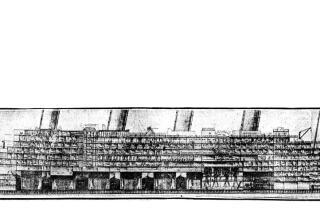A secret mission, torpedoes, sharks and the men who survived: The story of the ‘Indianapolis’
- Share via
With diligent reporting and sharp writing, Lynn Vincent and Sara Vladic have accomplished a daunting chore facing writers of historic nonfiction: take a story whose outline is known to the public and craft an account that is compelling yet comprehensive.
The result, with a strong narrative style and well reasoned point of view, is “Indianapolis: The True Story of the Worst Sea Disaster in U.S. Naval History and the Fifty-Year Fight to Exonerate an Innocent Man.”
The heavy cruiser Indianapolis was sunk by a Japanese submarine in the waning days of World War II. Books, television documentaries, a play and, of course, Steven Spielberg’s “Jaws” have told how the Indianapolis, having already delivered the “Little Boy” atomic bomb to Tinian, was sunk and how hundreds of survivors floated for days ravaged by hunger, dehydration, scalding wounds, salt-water poisoning and sharks.
Through negligence and bureaucratic incompetence, the Navy seemingly forgot about the Indianapolis for days and launched a rescue effort only when survivors were spotted accidentally by a Navy plane on routine patrol. In a brisk, fact-based narrative, “Indianapolis” mixes horror and scandal.
By the time the last survivor was pulled from the choppy ocean, three-quarters of the crew were dead or dying. An estimated 300 crew members went down with the ship, another 500-plus died in the water desperately waiting for rescue. The total number of dead was 879; there were 317 survivors.
The last survivors were pulled aboard a rescue ship, the Doyle, thanks to the brave actions of rescue pilot Adrian Marks, on the night of Aug. 3, 1945. “The last Indy sailor to be pulled up was Art Leenerman, whose corpse Marks had been towing,” the authors recount. “Just as the canvas sling crossed the Doyle’s rails, Leenerman sputtered awake, shocking his rescuers.”
Much of the account by Vincent and Vladic is centered on the fate of the Indianapolis’ skipper, Capt. Charles McVay III, a decorated combat commander. He survived the sinking only to face court-martial. One of the prosecution’s star witnesses was the submarine commander, Mochitsura Hashimoto, who fired the torpedoes that sent Indy to the bottom of the Philippine Sea in 12 minutes.
Hashimoto and his crew were zealous in their desire to sink a warship. Attached to the sub were aquatic kamikazes: mini-subs called kaiten armed with explosives. When it was initially unclear if Hashimoto’s torpedoes had struck the Indianapolis, “the kaiten pilots begged ‘Send us!’” even though the mission was suicide. Hashimoto declined, preferring to dive and reload.
The authors remind us that World War II was a conflict requiring full mobilization of the American homefront — from elite-college graduates to teenagers from impoverished families trapped by the Depression. Don McCall, a redhead from Illinois, was 18 when he reported to the Indianapolis as a seaman second class: “It was the first time he ever remembered having enough to eat. And they even paid him — eighteen dollars a month.”
As the Indianapolis’ sailors struggled in the water, there was bravery and self-sacrifice, all vividly detailed by Vincent and Vladic. There was also violence, cannibalism and even sexual attacks: “In the water, the dead outnumbered the living. Men continued to expire so quickly that it became almost impossible to move around without having to shoulder through shoals of corpses.”
And then the sharks: “one moment, [they] behaved like gentle and curious giants, moving up close to inspect the men with black unblinking eyes. The next moment they attacked, their steel-trap jaws snuffing out a man’s life before he could draw a breath to scream.”
At a highly publicized court martial, McVay was convicted of “failure to zig-zag” his ship. A zig-zag course was thought to help ships evade detection and targeting by submarines. The court was unmoved by testimony from Hashimoto that a zig-zag pattern would not have kept him detecting and sinking the Indianapolis.
There were no courts-martial for the officers who heard the Indianapolis’ SOS call and did nothing, had failed to notify the ship that enemy submarines were in the area, or then failed to notice that the ship was several days overdue. Instead some received written reprimands. Vincent and Vladic are particularly hard on Fleet Adm. Ernest King (“he was known to be vindictive”). He had ordered the court-martial before all evidence had been gathered.
When King retired, the new chief of naval operations, Adm. Chester Nimitz, set aside the guilty verdict. McVay was promoted and allowed to ride a desk until he retired in 1949. Hashimoto returned to Japan and became a Shinto priest, a family calling.
McVay did not live to see his (carefully worded) exoneration in 2000 by Congress after a lobbying effort by some (but not all) Navy officials, a teenager from Florida, and Indianapolis survivors who felt McVay had been made a scapegoat to cover up Navy blundering.
Some of the families of the dead never forgave McVay and routinely sent him “hateful letters that arrived like due-bills that could never be paid.”
McVay commited suicide in 1968, yet another victim, Vincent and Vladic assert, of the sinking of the Indianapolis.
Perry covered the wars in Iraq and Afghanistan as a reporter for The Times, which he left in 2015. He is writing a book about the Marines in World War I.
::
By Lynn Vincent and Sara Vladic
Simon & Schuster: 592 pp., $28
More to Read
Sign up for our Book Club newsletter
Get the latest news, events and more from the Los Angeles Times Book Club, and help us get L.A. reading and talking.
You may occasionally receive promotional content from the Los Angeles Times.








